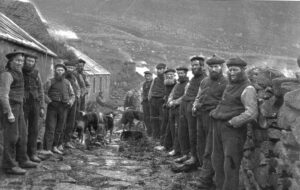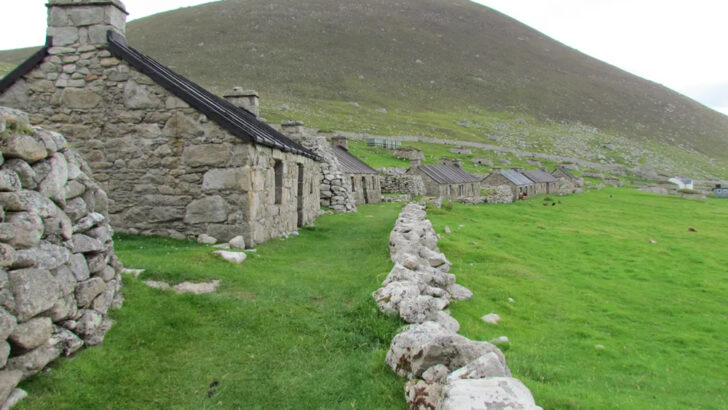The Gravity of Feathers: Fame, Fortune and the Story of St Kilda,
by Andrew Fleming
(Birlinn, £25.00 / €30.00)
The life and culture of our own offshore islands here in Ireland has long played an important part in creating our ideas about what Irish culture as whole is. The books of the islands themselves all have given insights into lives lived in conditions very different from those of most of us.
So much so that this book about the legendary island of St Kilda some forty miles from the nearest other land, some 14 hours it seems by air even today.
But who was St Kilda, readers may ask, noting the title of this book. The truth is that there never was a St Kilda; she was a “saint” unknown to the medieval Church. The title comes from a language confusion.
The Scottish off-shore island, out in the wild seas of the North Atlantic from the nearest other part of Scotland, whose history this book explores did not take its name from her; she was invented to explain the island’s name.
This strange sequence, however, is quite in keeping with the long and convoluted history of perhaps Scotland’s most famous offshore island, a place that has fascinated southerners since the middle ages.
Macleod
In the very first chapter the author reveals his discovery of evidence of Neolithic, even a Mesolithic occupation. He sees the islands as remote, as so many do. But he does not discuss the fact that the island stood in the stream of the sea-borne culture of the western European sea coast from very earlier times, along which nearly every major cultural change was carried down to the advent of the Iron Age.
But what we really know for certain about the island begins with Martin Martin’s 1698 account of them, A Voyage to St Kilda. This was widely read as it seemed to reveal an ideal early community. It inspired Dr Johnson and Boswell to undertake their “Highland Jaunt” in 1773, as well as many others including the present reviewer. Like them I only got as far Iona, but by the 1970s St Kilda was beyond easy reach.
The MacLeod of the day wanted to dispose of the islands he offered them at any price to potential buyers; the idea of giving it over to those who lived there never entered his mind”
The island was the property of the MacLeods — to which family Martin was tutor. But they or rather their agent or rent collector – called a “tacks man” in Scotland – soaked the island of its produce for centuries.
This is truly the part of the story that will arouse anger in some readers. When at a later date the MacLeod of the day wanted to dispose of the islands he offered them at any price to potential buyers; the idea of giving it over to those who lived there never entered his mind.
For the landed gentry all land is wealth – even a speck in the distant ocean like St Kilda. In Scotland the “Land War” of the 1880s took a less aggressive form, not being backed by a political party. The Liberals held the Highlands, the emerging socialists industrial Clyde side. The islanders were little thought of by either: they had votes alright, but nowhere to cast them.

Vocation
The religious life of the off-shore islanders in the two countries was very different. There were churches on our Aran, a Catholic chapel and Church of Ireland church. But on the Blaskets, as on so many other islands, to attend a service the islanders had to row ashore, weather permitting.
On St Kilda there was a Presbyterian minister; but the teaching of Calvin and Knox seem somehow to be ill-adapted to the hard life of the people. The minister and his wife seem to have provided little real spiritual comfort to the people, at least in the sense that their Catholicism seems to have done for our islanders. On St Kilda there was a hard creed for a hard life, which had at times led to protest and even revolt by the congregation, not surprisingly.
The creation of a summer steam ship link brought tourists, and also the possibility of a trade in the islander’s woven tweeds. These were sold in classy urban shops as a significant mark up; not much of the money they raised made its way back to St Kilda. The islands were often seen as “lazy” in the same way that Africans and Mexicans are by some Americans; yet the women were never far from their spinning wheels, the men toiled all night often at their looms. Indeed at times one feels one is reading about some exploited colony in Africa or Asia.
The most striking and intimate chapter is one based on the records kept in the first decades of the last centre by the nurses posted to the island by the government. Here the information gets close to how life was really lived there.
One striking aspect of this history is that neither before or after the evacuation of St Kilda was any attempt made to get any one of the islanders to relate their own life stories, as was made on the Blaskets. Hence though the author’s research has been wide ranging over many aspects of island life, when it comes to the mind and feelings of the natives none of them speak for themselves.
No-one gave them the inspiring exemplar of Maxim Gorki’s My Childhood, that had such a profound effect on the Blasket writers; no Scottish Mrs Kennedy came to ask questions of the island women about their experiences, and see to their recording. So over the inner life of St Kilda a great silence prevails.
This is a book which many people in Ireland will read with great interest, remarking as they do how different the course of modern history has been in the two countries. From that point of view this is a book not to be missed. One wonders if the model of Irish independence (however flawed it may seem to some) will remain to have some effect on the future of Scotland in the post-Brexit decade to come.
The enigmatic title may well puzzle readers as well; but its origin is only explained some forty pages in that the author “couldn’t resist” adopting it from a semi-facetious book of 1815. In general authors should resist such urges. For clarity of purpose, indeed mere truth, St Kilda is better served by a straightforward title for a place with “a history like no other”.
The islands were often seen as “lazy” in the same way that Africans and Mexicans are by some Americans; yet the women were never far from their spinning wheels, the men toiled all night often at their looms”


 Peter Costello
Peter Costello The abanonded island today.
The abanonded island today. 